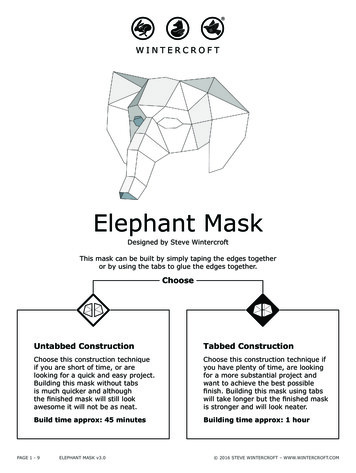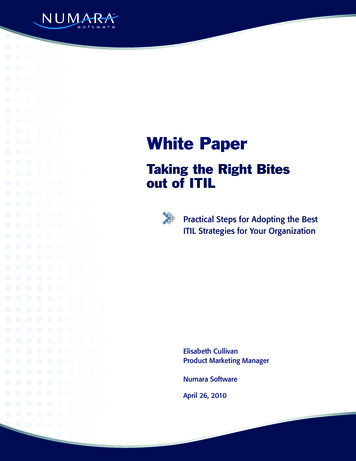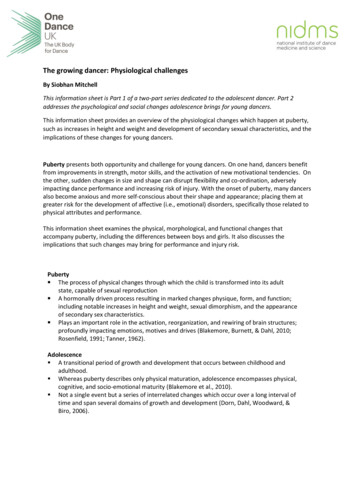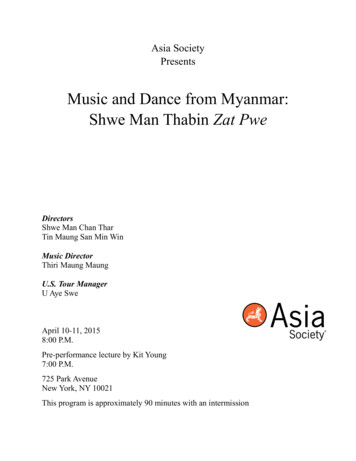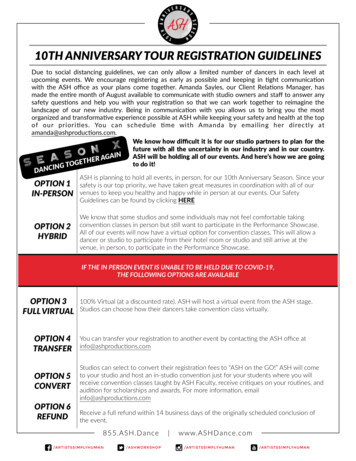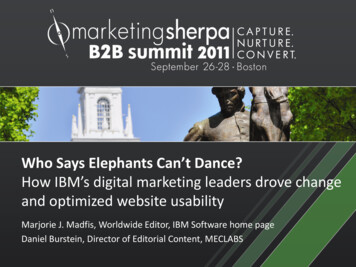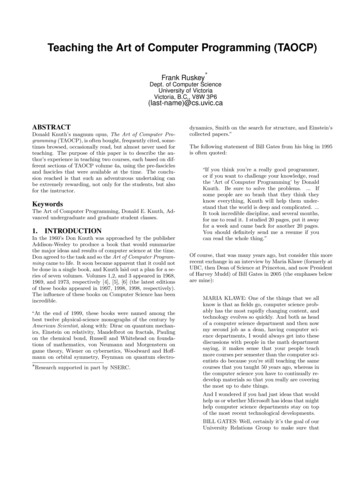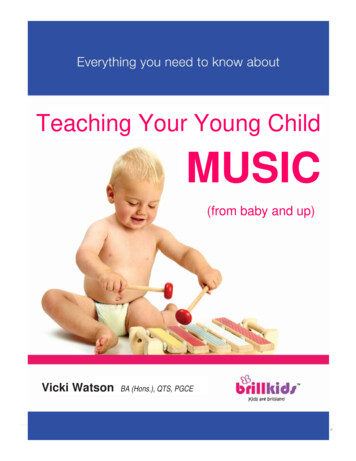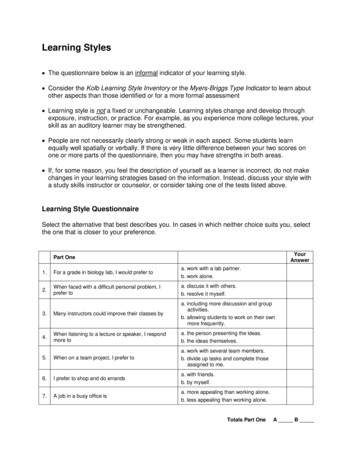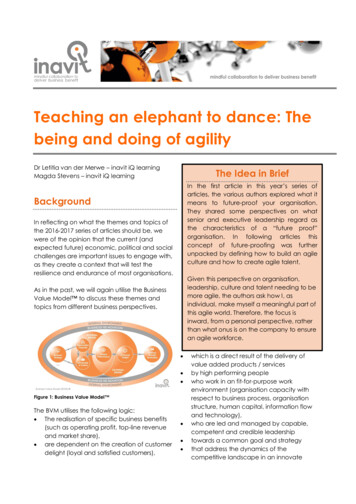
Transcription
Teaching an elephant to dance: Thebeing and doing of agilityDr Letitia van der Merwe – inavit iQ learningMagda Stevens – inavit iQ learningThe Idea in BriefIn the first article in this year’s series ofarticles, the various authors explored what itmeans to future-proof your organisation.They shared some perspectives on whatsenior and executive leadership regard asthe characteristics of a “future proof”organisation. In following articles thisconcept of future-proofing was furtherunpacked by defining how to build an agileculture and how to create agile talent.BackgroundIn reflecting on what the themes and topics ofthe 2016-2017 series of articles should be, wewere of the opinion that the current (andexpected future) economic, political and socialchallenges are important issues to engage with,as they create a context that will test theresilience and endurance of most organisations.Given this perspective on organisation,leadership, culture and talent needing to bemore agile, the authors ask how I, asindividual, make myself a meaningful part ofthis agile world. Therefore, the focus isinward, from a personal perspective, ratherthan what onus is on the company to ensurean agile workforce.As in the past, we will again utilise the BusinessValue Model to discuss these themes andtopics from different business perspectives. Figure 1: Business Value Model The BVM utilises the following logic: The realisation of specific business benefits(such as operating profit, top-line revenueand market share), are dependent on the creation of customerdelight (loyal and satisfied customers), which is a direct result of the delivery ofvalue added products / servicesby high performing peoplewho work in an fit-for-purpose workenvironment (organisation capacity withrespect to business process, organisationstructure, human capital, information flowand technology),who are led and managed by capable,competent and credible leadershiptowards a common goal and strategythat address the dynamics of thecompetitive landscape in an innovate
manner that builds the business brand andreputation.double the work, in half the time, with half theresources.In the first article in this year’s series of articles,the authors explored what it means to futureproof your organisation. They shared someperspectives on what senior and executiveleadership regard as the characteristics of a“future proof” organisation. In following articlesthis concept of future-proofing was furtherunpacked by defining how to build an agileculture and how to create agile talent.In this article, the “being” of agile and the“doing” of agile will be unpacked. Thedifference is more than mere semantics.According to Hanoulle,1 it is the distinctionbetween “why” you are doing agile, rather than“how”. Agile, for example, is more about howyou approach problem solving and less aboutthe tools used to support that approach. Agile isreally a mindset, followed by the doing of agile.Given this perspective on organisation,leadership, culture and talent needing to bemore agile, we want to focus on PeoplePerformance, in asking ourselves the question,how I make myself a meaningful part of this agileworld. Therefore, the focus is inward, from apersonal perspective, rather than on the onus onthe company to ensure an agile workforce. Inthis article we will attempt to teach an“elephant to dance.”The “being” of agileIn this section we willfirstly unpack the“being” or mindset ofagile. Getting anelephant to dancestarts with the elephantthinking s/he candance, and theningraining this into theactual “being” of the elephant. Agile peopleIntroductionhave a propensity to seek improvements, are“It isn’t a question of whether elephants canmore willing to consider information that is atprevail over ants. It’s a question of whether aodds with preconceived notions, and are moreparticular elephant can dance. If it can, the ants willing to be different and take risks – accordingmust leave the dance floor.”to David Alberts2. We believe the following― Louis V. Gerstner Jr., Who Says Elephants Can't defines some of the characteristics of the beingDance?of agile people: InquisitiveThe book mentioned above is an account of ResilientIBM's historic turnaround as told by Louis V. Able to let goGerstner, Jr., the chairman and CEO of IBM from Willing to embrace the unknownApril 1993 until March 2002. Lou Gerstner led IBMInquisitivefrom the brink of bankruptcy and mainframeobscurity back to the forefront of the technology "The important thing is to never stopbusiness. Here he referred to a big organisationquestioning." -A. Einstein.as an elephant – probably a metaphor stillrelevant today. And maybe even relevant topeople in this day and age who feel constrained 1 itby organisational bureaucracy and anmean-have-agile-mindset?overwhelming sense of being required to person
Agile people are inquisitive people – they arewhat we call “professional question askers”.Toddlers are constantly asking “why?” and “whynot?” We live in a world that has become sointent on finding a specific answer that weconstantly ask the wrong question. Agile peopleask new questions. Agile people are able to letgo of their own pre-conceived ideas.In their article "Quarterbacking Real and RapidOrganizational Improvement,"4 the authorsemphasised how important it is to makeadjustments: "It is imperative to makeadjustments quickly when things are not workingas planned. One of the most important findingsabout successful leaders of change is the simplefact that they tend to be very timely in makingdecisions, solving problems, removingroadblocks, and fighting the tyranny of theurgent."ResilientWriters of all kinds have commented, in manydifferent ways, on the fact that human life ischaracterised by constant challenges toindividuals, groups and communities. Some ofthese challenges are merely hassles, while othersare of a more serious nature. Fact remains thatone cannot experience life without at leastsome pain, and sometimes a great deal of it.It appears that agile people are able to let go. Itis probably very hard to let go of something thatworked in the past, in which a lot of time andenergy has been invested. To let go is not to tryand change or blame another or a situation; it’sto make the most of yourself. To let go is not tobe the saviour every time someone makes amistake. To let go is not to deny reality, but toaccept that what cannot be changed. To let gois not to regret the past, but to adjust to the hereand now. To let go is not to give up and admitdefeat.According to Borenstein,3 “Resilient peoplequickly zero in on challenges and devisestrategies for dealing with them, whether it isasking for help seeking out resources learning new skills or striking out on novelpaths. They call on their inner strength andrecruit outside resources to keep movingforward, and they tweak their futureexpectations to fit their new reality, be it the lossof a loved one, a life-changing diagnosis, or adevastating financial blow”.Embrace the unknownIn this VUCA (Volatile, Uncertain, Complex andAmbiguous) world, we yearn for simplicity andclosure. As previously stated, we live in a worldthat places more value on finding answers thanon asking questions. Despite understanding thatbusiness is multifaceted, there is a need for us tosimplify. Einstein said “Everything should bemade as simple as possible, but not simpler.” Itseems that we want to be able to predictoutcomes and tightly control the path toachieving these outcomes.Agile people have the ability to bounce backfrom setbacks.Letting go“Leadership skill: let go. You can only lose whatyou cling to” – Buddha.Agile people, though, make a conscious effortto steer away from the trusted and known, toembrace the unknown. Embracing theBorenstein, D.B. 2002. How do we bounce back fromadversity? Psychology Today, ganizational%20Improvement.pdf3
unknown, however, is not the modern proclivityof jumping at each new management fadwithout the slightest idea as to whether it willactually improve a business.simultaneously improve the agility of direction,focus, speed, quality, and sustainability.In the next section we will explore a couple ofperspectives of “doing” more agile, namely:It seems to us that our rapidly changing business Becoming more resilientcontext is like a treadmill that compels people to Develop a systems thinking approachbe constantly curious, willing to give up on Asking questionsfamiliar approaches and to embrace the The art of letting gounknown. Easily said – but how does one do it?How to become more resilientThe doing of agileResearch has shown us that resilience usuallyconsists of three primary categories: Physical wellbeing Mental wellbeing Living a purposeful lifeHaving explored the characteristics of ”being”agile, the question is,what gets in the wayof “doing” agile?How do you improveyour agility? Youcommit to doingsomething differently– the elephant startsto dance.All of these categories are interlinked, but noneof them can be ignored if long-term resilience isto be developed.Physical wellbeingThose with a good physical wellbeing simplyBelow is a video clip that demonstrates how our have more energy to deal with the challengesindividual beliefs – along with the collectiveof modern life. This category is one we oftenmindset in our organisations – combine to create understand and yet give limited attention to.a natural but powerful immunity to change.Keys to physical wellbeing – decide today topay more attention to your physical wellbeing.Mental wellbeingIt is essential to stay in touch with what is reallyhappening now, instead of limiting ourselves byadhering to beliefs and assumptions from thepast that may no longer be relevant. The mentalperspective of resilience is based on ourattitudes, beliefs and assumptions, rather thanknowledge.(Click on icon to play video)https://www.youtube.com/watch?v FFYnVmGu9ZIAn Evening with Robert Kegan and Immunityto ChangeSo, at least from our perspective, the doing ofagility starts with how we think.Keys to mental resilience: Question assumptions,The doing of agile requires a systems-basedattitudes, and beliefs, and actively manage yourapproach. It takes far more than willingness,thinking consistently.open-mindedness and flexibility. It is important topay attention to the whole system and4
Living a purposeful lifeHaving a strong sense of life purpose andaligning your professional world with thatpurpose creates a strong foundation forwellbeing.work through high leverage solutions over time.To us this also implies a deep commitment tolearning: i.e. they must be prepared to bewrong, to challenge their mental models, totriangulate and collaborate to see collectivelyand know that it may require time to address theproblem.Keys to Purpose: Have a clear life purpose,develop skills in self-management, andappreciate and work with your emotionsregularly.Working smarter means working in ways that arecollective and are based on collectiveintelligence across cities and supply chains toproduce social, ecological and economic wellbeing.In their article "Building Agility, Resilience andPerformance in Turbulent Environments", theauthors5 emphasised the importance of asystemic approach to building organisationalagility:"We are struck by how the agility and resilienceliteratures focus on individuals, team, andorganisations, but rarely two or more of these atthe same time. Emphasizing agility-buildinginterventions such as systems thinking or creativeproblem-solving workshops at an individual orteam level may be helpful, but if efforts to buildagility across the organization are weak, thenindividual and team-level efforts ultimately fail."https://www.youtube.com/watch?v HOPfVVMCwYgPeter Senge, author of The Fifth Discipline,Senior lecturer at MIT and founder of theSociety for Organizational Learning shareshis perspectives on leadership and systemsthinking with IBM.Systems thinking involves both a mindset thatfocuses on how the parts of a whole areinterrelated and a set of tools that helpsorganisations examine complexity. Some ofthese tools that you might like to explore include: Systemic enquiry; OODA Loop; Critical chain project management; and Rich pictures.In the next section we will focus on the conceptof systems thinking – a useful framework forpeople wanting to make sense of a morecomplex world.How to develop a system thinkingapproachPeter Senge made the concept of systemsthinking popular. In his work he focuses on theproblems that are most difficult to solve and themental models today's leaders need in order tobuild a smarter planet. According to him,leaders today need to be able and prepared toreassess their strategies, work across multiplegroups to find solutions and have the vision toIn the next section we will provide some insighton how to ask more open-ended questions.How to ask more questions“I’ve learned that asking questions isn’t a sign ofweakness; rather, it demonstrates curiosity,engagement and intelligence." Agility.pdf5
Agility is a way of working that enables us tocomfortably question and explore alternatives.The good news is that we are born agile andthat your mind-set is not fixed, therefore we canencourage each other to become more agile.The purpose of the questioning, listening andreflecting is to look ahead and take action byfinding direction, planning, and setting goalswithout focusing on preconceived ideas.The art of letting goLetting go is probably so difficult because it feelslike failure to us. Most people can probablyrelate to a business example of a time when aproject or idea met all the outcomes, was ontime, within budget, but just didn’t deliver theenvisaged value. How does one let go of this?So how does one let go? It starts with the decision to let it go ‒ acceptthat you have a choice. Admit how you feel – get it out of yoursystem. Sometimes it’s about acceptingthings for what they are. Define your identity in your life purpose – notwhat you have accomplished in the past. Itwill then be easier to let go of things. Don’t play the victim or blame others. Move on.The Centre for Action Learning devised thefollowing questions that can help to get youstarted on the journey of asking more questions:Head question - Thinking – ideas, facts, theories,assumptions. Traditionally thought of asassociated with the head, and is termedcognitive by psychologists Whose help do you need? Whom have you spoken to so far? Who has specialist knowledge? How do you interpret all that data? Can you see a pattern emerging? What sense are you making from thefeedback you are receiving?CloseThe “being” and “doing” of agile is anopportunity and challenge and a way we canhave an impact on every aspect of the business.Agility is a systems-based capacity, not asingular trait or characteristic of a person – it isabout the “being” and “doing” of agile. Agileprofessionals bring together people, processes,and systems to realise the organisationalstrategies (and letting go of the ones that nolonger work).Heart questions - Feeling – feelings, emotions,moods. Traditionally associated with theheart, termed affective by psychologists. Why is this problem/challenge soimportant to you? How did you feel when you heard that? Would you be surprised if others felt thesame/differently?Hand questions - Doing ‒ will, intentions,movement, action. Traditionally thought of aslimbs particularly hands and is termedconative by psychologists What alternatives are there? What will you do next? If your plan is accepted, how will you tellthe team?In the final section we will conclude by providinga framework for how to let go.6
“elephant to dance.” Introduction “It isn’t a question of whether elephants can prevail over ants. It’s a question of whether a particular elephant can dance. If it can, the ants must leave the da
